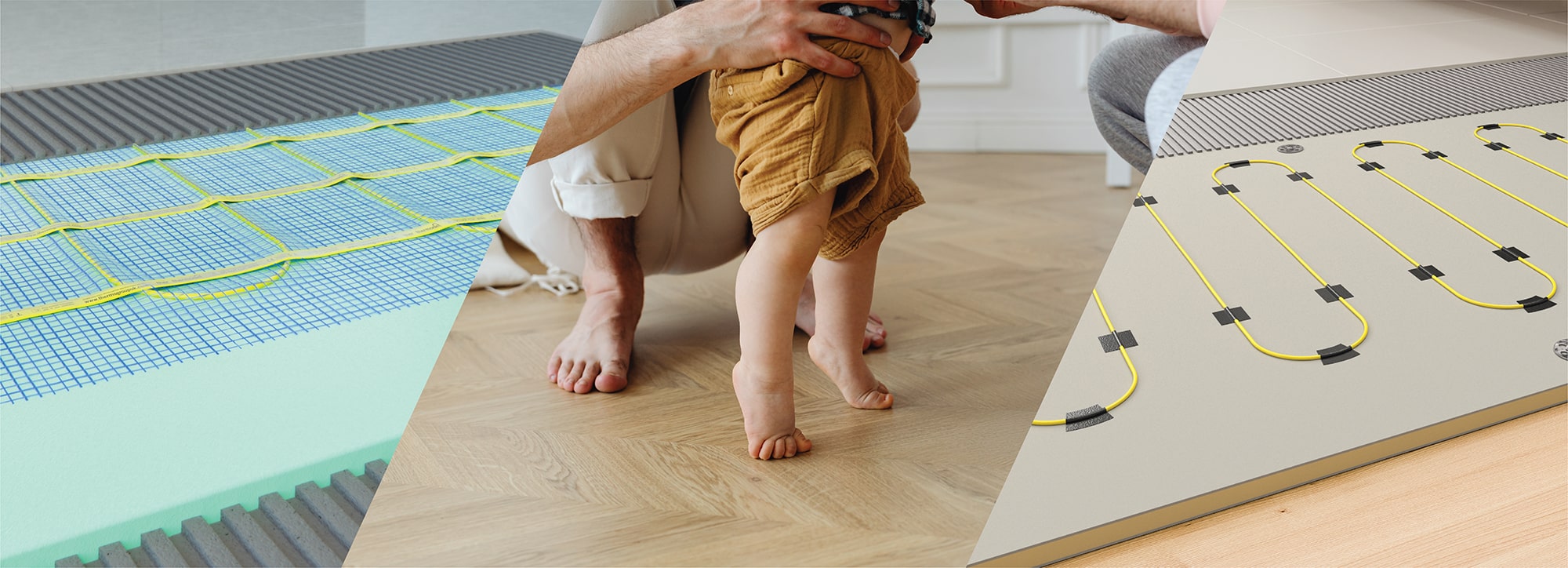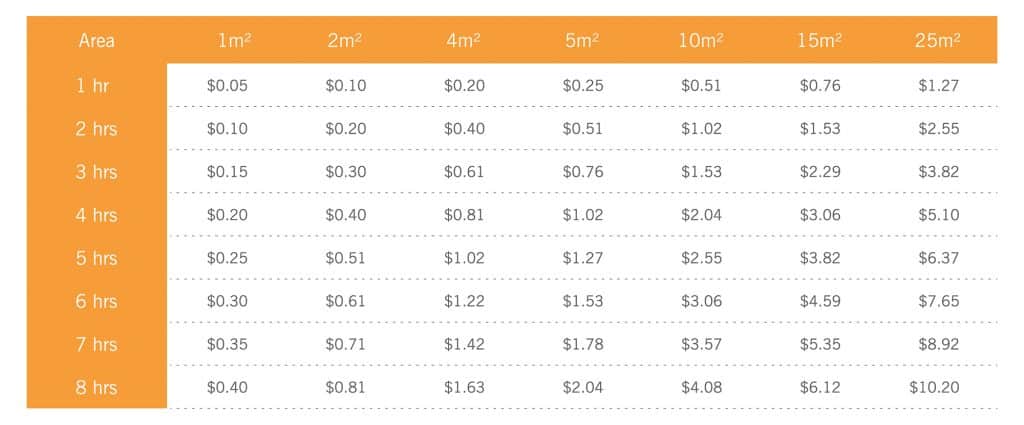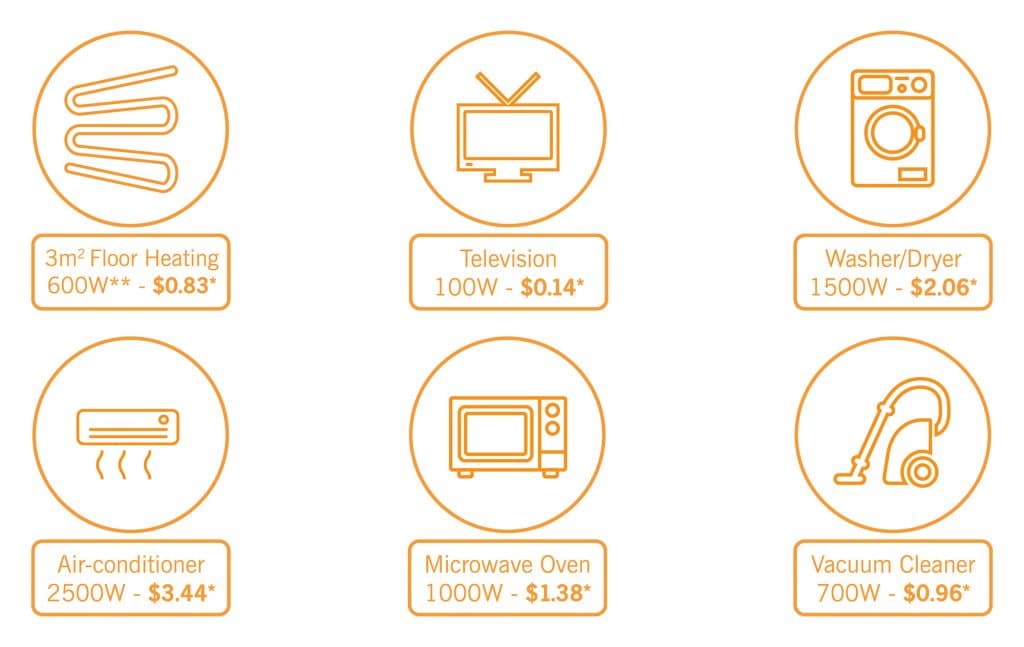
This is another question that we get asked time and time again, and unfortunately, like so many commonly asked questions, the answer isn’t all that straightforward. In fact, the answer is really, that it depends.
We know that an answer like this isn’t what you are after though, so we have drilled down into the running costs of Underfloor Heating and looked into:
If you just want to cut straight to some numbers on how much Underfloor Heating costs to run, you can view our running cost tool and put in your details however we believe it would be worth you checking out the below first to get a full understanding of the costs.
Lastly, we have given this in the context of a bathroom however the same principles apply to any room of the home.
Let’s get into it.
What drives costs up?
There are several key aspects that drive costs up and with most, the obvious observation is that the opposite action will drive the price down.
Heating Time An obvious one, the longer the heating is on the more it will cost to run. We know it’s obvious but we often find that people leave the heating running the whole time which is going to drive up the running costs. With a system installed directly below your floor finish the heat-up times will be quite rapid, so once you find out the heat-up times for your room, set up a schedule accordingly so that it heats up and is warm when you need it.
If you can reduce the time your system is heating you will help to reduce your Underfloor Heating running costs.
Lack of Insulation resulting in high heat loss Again it seems pretty obvious that if you don’t insulate you will have high running costs, due to heat loss.
Customers often think that we offer insulation as a upsell product but the fact is that insulation truly will help to drive down your running costs.
Heat moves equally in every direction as opposed to hot air which means you are going to lose some heat down into the substrate rather than it all being pushed up into the room. It’s not just about the floor though, uninsulated walls or ceilings will also allow heat to rapidly escape. Even worse, an old window frame that isn’t well-sealed is going to result in high heat loss. You can find out more regarding insulation here.
To be clear, if you are lacking insulation that results in high heat loss then you will be increasing the running costs of your underfloor heating, as the heating will have to work harder to combat this loss.
- Your set temperature
So many times we see people overlook the temperature they run their Underfloor Heating at as they don’t realise the influence that this has on their running costs.
Like most heating, you ideally want the room to be comfortable so you want to run your heating at around 22-24 degrees. If you run it higher than these temperatures what typically happens, is that the additional heat is lost and your heating will be running longer trying to reach your higher set temperature.
If you are running your heating at over 25 degrees then you are driving up your running costs. To help bring down your running costs drop your temperature a few degrees. Of course, make sure it’s still comfortable in the room. In most cases we find that when clients reduce their set temperature a couple of degrees they do not notice the difference in the heating but will notice a difference in their running costs.
- Size of the room
Again it’s obvious, that the bigger the area that you are trying to heat the more expensive it is going to be to run. This is one that you can’t really avoid, you don’t want to compromise on your heating though, and you don’t want to end up with cold sections on the floor. Just consider any areas in the room that won’t be used such as the void down the side of the bath or in a living room under any large permeant furniture fixtures where you won’t need to install the heating.
The other way to combat the large areas is through zoning. In large living areas consider zoning the heating so that you don’t have to have all areas on at the same time, allowing you to just heat the areas you are using. This will also help to reduce your running cost.
If you can reduce the size of your system you can bring down the ongoing running costs of your electric floor heating.
If those are some of the key factors that drive costs up, then what are some of the key factors that drive costs down?
What drives costs down?
Some of the points above have already covered how to drive down the running costs of your electric floor heating so we will keep the below simple.
Set up a heating schedule
As mentioned you don’t want to leave your heating running the whole time so set up a heating schedule based on your lifestyle so that you aren’t heating when you don’t need it. Particularly make sure you turn off any heating periods when you won’t be using the room as these will be a great way of driving down the costs of your electric Underfloor Heating.
Turn the heating off when you leave the room
Another great tip is to switch the heating off when you leave the room. Especially in a bathroom, if the heating is on a schedule and you are using the bathroom early then switch the heating off before you leave the room and it will pick up the schedule at the next switching period.
Insulate the room
We touched on this as an area that can drive the costs up but we wanted to emphasise it again. Insulation is truly the most effective way of driving your costs down. It might be more upfront, but it will pay itself off in the long run. You can find out more about insulation here.
Keep the room warm
Sometimes you can’t increase the insulation in the room once it’s built however you can take small steps to help keep the room warm. Keep windows and doors closed as much as possible so that heat can’t escape, particularly with a bathroom, keep the door closed at night so the heat is trapped in the room as it begins to heat up.
Green Energy – Using Solar to drive down your running costs
In a time when we are all concise about our electricity usage, we are seeing a surge in the popularity of solar panels on homes, which means more and more homes are offsetting their electricity costs. If you are one of the many Australians that have invested in solar for your home you are going to be well placed for reducing the running costs of your electric Underfloor Heating.
So that covers some of the key drivers behind how much Underfloor Heating costs to run. Before we get to some numbers there are two final points we want to make regarding the running costs.
- Our systems are all-electric so the electricity tariff in your area will directly influence your electricity bill. Check out the electricity tariff in your area when considering some of the numbers below.
- Secondly, the brand of Underfloor Heating won’t influence the running costs, any brand that is drawing an equal equivalent wattage will cost the same to run so you don’t need to go shopping around by brand to see if you can reduce your running costs.
Running costs of Underfloor Heating
There are several different electric underfloor heating systems, from mats to loose wire to foil systems. The fact is that the different systems don’t make a lot of difference to the costs, if you are lifting the floor temperature from 16° to 22° each system will be drawing roughly the same amount of electricity.
A standard 3m2 bathroom with a 200w system installed below the screed will be drawing 600watts when heating. Based on an electricity tariff of 35c/kWh it will cost 5c per square meter to run, or effectively 15c for that bathroom per hour.
The table below helps to show the running costs of your electric Underfloor Heating.
You can also check out our online pricing calculator here.

The diagram below shows the electricity draw compared to other appliances in the home. Remember your bathroom of 3m² is drawing 600W.
* Daily running cost based on running for four hours per day.
** Based on 200 Watts per square metre.
Lastly the coffee story
Yep, we said at the start we had a coffee story. We find this one makes a lot of sense to people wondering about the running costs of their Underfloor Heating.
We just agreed a typical bathroom of 3m² with an Inscreed system is costing 15c an hour to run so let’s crunch some numbers.
15c x 4 hours a day (2 hours in the morning and 2 hours in the evening)
= 60c per day
60c x 7 days = $4.20 per week to run your bathroom.
That means that your bathroom of Underfloor Heating for a week is costing the equivalent of a standard takeaway coffee. Most people are guilty of buying more than one takeaway coffee a week without giving it too much thought.
Summary
In summary, the answer to the question of how much Underfloor Heating cost to run is a tricky one to answer. We have gone over what drives costs up and what drives costs down and have given some examples, as well as referencing our running cost tool.
We firmly believe though from all that we have gone over that Underfloor Heating is a cost-effective way to keep your home comfortably warm. We accept it’s probably not the cheapest way of heating the home however we certainly won’t be swayed from the fact that it is the most comfortable.
We hope that this has given you an understanding regarding the running costs and that you choose find Underfloor Heating as the preferred heating system for your home. If you want to discuss your specific requirements further please don’t hesitate to get in touch and we will be happy to discuss.

Calculate your Underfloor Heating daily usage
|

Question not answered yet? We are here to help
|

